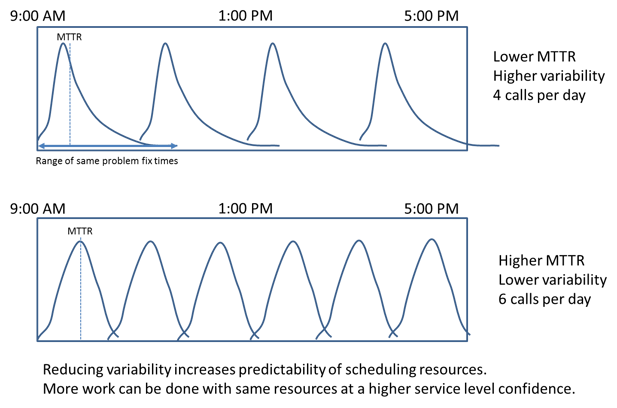If the name Garrison Keillor rings a bell, you know that in Lake Wobegon, “all the children are above average.”
“We just want you to be average.”
I used to work with a field service manager who was fond of telling technicians “We just want you to be average.”
I asked once why he didn’t want them to be excellent, or even very good. He showed me graphs charting the time it took different technicians to solve the same problem on different calls. These graphs of “same issue resolution time” all looked the same: A bell curve skewed to the left, that showed a short tail of techs solving the problem quickly, the peak of the curve near the mean time to repair (MTTR), about 2/3 of the techs solving the problem within half an hour on either side of the mean, and then a long tail to the right of techs taking a lot longer to solve the problem. Then he said, “It’s not the mean that is killing us, it’s the variability. If techs would perform closer to the mean, we could handle more calls per day.”
Then he told me the part that seemed radical: “In fact, we could even increase the MTTR, but if we drive the variability down enough (i.e., shorten the tails), we could handle 25% more work with the same workforce.”
That’s right – in Field Service Management - if we increase the average time to repair, but have performance closer to the mean, we can do more work (see the inset for an illustration).

So how can we help make your technicians be more “average”?
- Focus on task-oriented content – how to diagnose, repair, and test. Task-oriented procedures are the essence of best known methods, and providing them this structure will have them all running the same plays.
- Give them information they need, in a useful format. Technicians won’t use paper-based documentation for lots of reasons. Give them information they can search and display on their go-to portable device.
- Give them information they can trust – that is current, authoritative, and reflects the world they operate in – which is not the world the technical writer envisioned when the product launched.
- Help them collaborate to solve emerging issues that aren’t documented, and make their collaboration searchable.
- Measure what they use and search for – and use this to inform what information is missing, and what deserves to be better.
For a look into how we use information architecture as the foundation for digital transformation read our whitepaper: "Knowledge is Power: Context-Driven Digital Transformation.
